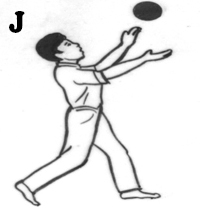Basic Concept of Balance

Why Vestibular Exercises?
• A problem with balance and equilibrium causes vertigo.
• Vestibular exercises help reduce the symptoms of vertigo and aid to regain balance.
• Vestibular exercises do not treat or regenerate a damaged organ.
• Vestibular exercises improve brain’s compensation for injuries or abnormalities within the balance system, thereby, building up tolerance in brain to overcome symptoms of vertigo.
Aims of Vestibular Exercises
• Relaxing the neck and shoulder muscles.
• To train movement of the eyes, independent of the head.
• To practice head movements that cause dizziness.
• Improving general co-ordination.
• To become accustomed to moving about naturally in daylight and in the dark.
• To encourage the re-building of confidence in making easy, relaxed, spontaneous movements.
Prerequisites
• Medical advice/ instructions.
• Safe environment to reduce the risk of injury.
• Slow to begin with, and gradual progression to faster movements.
• Presence of another person during the first few times, to help in case the dizziness becomes severe.
How many times and days?
• 3 times a day / Everyday.
• Work up to doing each movement 20 times.
• If symptoms become too severe, take a break.
• Minimum of 6 to 12 weeks or until the symptoms goes away.
• Exercise can be stopped when no symptoms occurs for two consecutive weeks.
• Can be restarted again at any time if dizziness returns.
Exercises (Cawthorne Cooksey)
1. In bed
• Eye movements: at first slow, then quick

• Head movements: at first slow, then quick. Later with eyes closed.
✦ Turn from side to side
✦ Bend backwards andforwards
✦ Move head diagonally up and down towards right side
✦ Move head diagonally up and down towards left side

2. Sitting
• Eye movement s and head movement s as above.
• Shoulder shrugging. [A]
• Shoulder circling. [A]
• Bending forward and picking up objects from the ground. [B]
• Turning head and trunk alternatively to left and right. [C]

3. Standing
• Eye, head and shoulder movements as above.
• Change from a sitting to a standing position with eyes open, then closed. [D]
• Change from sitting to standing and turn round in between.

More challenging exercises
4. Standing and throwing
• Throw a small rubber ball from hand to hand above eye level.[E]
• Throw ball from hand to hand under one knee.[F]

5. Walking
• Practice walking in a straight line for 5 minutes with one foot
in front of the other or “heel to toe”. Start with “almost heel to toe” and gradually work to “heel to toe” touching.[G]

• Walking up and down a flight of stairs.[H]

• Walk across the room, first with eyes open, then with eyes closed (at tempt only with assistance).[I]

• Throwing and catching the ball while walking. [J]

Specific Eye Movement (Oculomoter) Exercises
1. Smooth pursuits
• Hold a single target.
• Keep eyes fixed on target.
• Slowly move it while head stays
still.
✦ side-to-side
✦ up-down
✦ diagonally

2. Saccades
• Hold two stationary targets placed inches apart.
• move eyes quickly from target to target as head stays still.
✦ side-to-side
✦ up-down
✦ diagonally

3. Gaze stabilisation
• Keep eyes fixed on single stationary target held in hand.
• Move head side to side.
• Move head up and down.

4. Head/eyes moving in same direction
• Hold a single target.
• Keep eyes fixed on target.
• Slowly move target, head/eyes in same direction
✦ side-to-side
✦ up-down
✦ diagonally

5. Head/eyes moving in opposite direction
• Hold a single target.
• single target, keep eyes fixed on target.
• Slowly move target, head/eyes in opposite direction
✦ side-to-side
✦ up-down
✦ diagonally

Benefits of Vestibular Exercises
• Non invasive.
• Cost effective.
• Returns or restores everyday function.
• Patient friendly.
• May be the best or only management.
Difficulties with Vestibular Exercises
• Not difficult to learn, but to achieve maximum benefit, commitment is needed.
• Exercises can be tedious. Therefore, fixed schedules to incorporate them in lifestyle is important.
• Symptoms may seem to be worse initially. With time and consistent work, symptoms should steadily decrease.
• Associated health conditions and medications may affect the recovery. Assessment of such conditions and appropriate management is needed.
Alternatives of Vestibular Exercises
• Active sports
( Basketball, Tennis, Ping-pong, Volleyball)
• Gaming consoles
• VR games
• Yoga
• Tai chi


